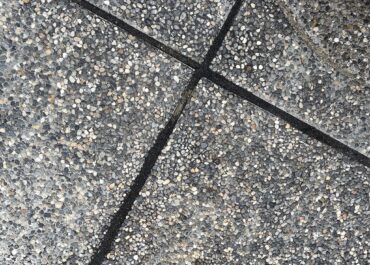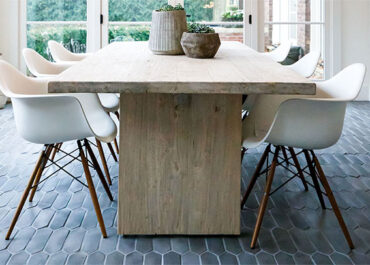
Do travertine pavers get hot or not? You may know by now that travertine pavers are the modern darlings of design enthusiasts – adorning the surroundings of backyard patios, barbecue areas, and poolside installations across the country. And rightfully so: travertine is not only beautiful but cost-beneficial as well, raising the value of many properties when properly taken care of.
But here’s the thing: do travertine pavers get hot under the sun like concrete slabs do? This annoying thought prevents several people from designing their outdoors around a dream paver project – especially when it comes to poolsides. Nobody wants to get their feet burned during fun summer times.
In this article, you’ll see whether travertine gets hot enough to compromise your investment and enjoyment of the outdoors, as well as some valuable precautions we must take to unlock its full potential.
Do travertine pavers get hot?
They do – but not as badly as many think.
Think about it this way: like most natural stone materials, travertine tends to absorb heat from the sun and retain it. When it has been exposed to direct sunlight for extended periods, particularly in warmer climates, the surface of travertine pavers can become quite warm, which may be uncomfortable to walk on with bare feet.
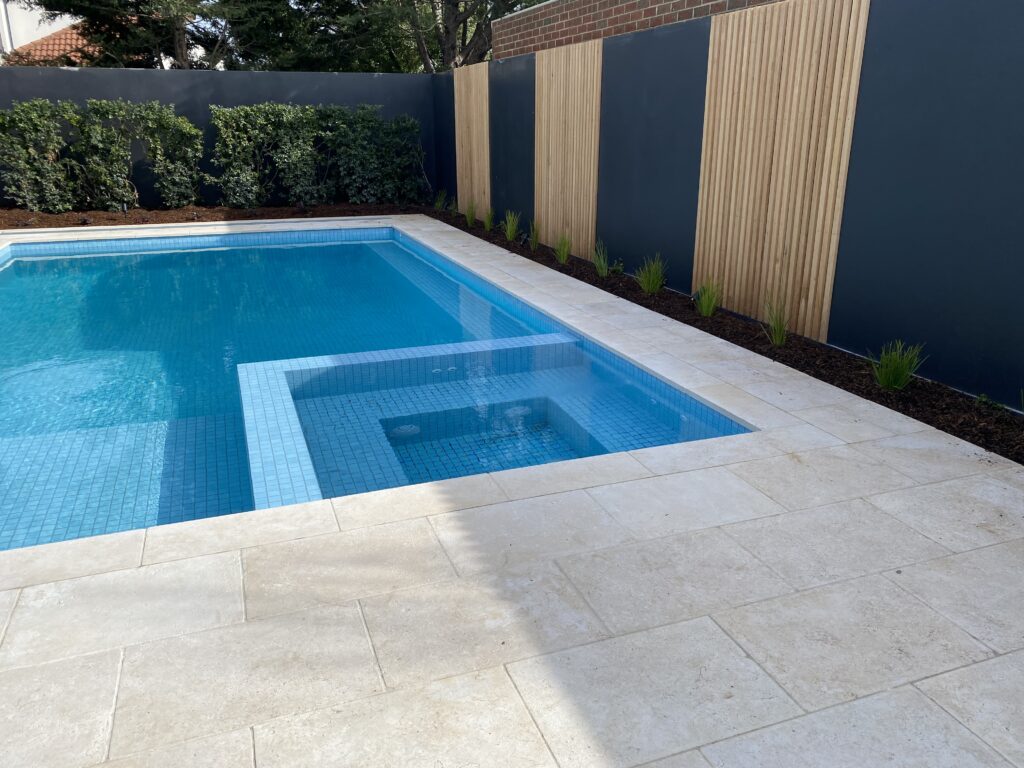
However, compared to some other materials like concrete or asphalt, travertine typically doesn’t retain heat as intensely. Its light color and porous nature can mitigate heat absorption to some extent. Additionally, the texture of the surface can affect how hot it feels; rougher surfaces may dissipate heat more effectively than smoother ones, for instance, so it all comes down to circumstances.
An alternative answer would be that travertine is extremely heat-resistant – being able to withstand temperatures as high as 85 degrees, which says a lot. As we’ll see in the next section, its advantages far outweigh the potential drawbacks, hence its high demand nowadays.
Read as well: How to clean travertine pavers
How does travertine compare to other pavers?
The ability of various types of pavers to withstand high temperatures can vary depending on factors such as composition, color, and surface finish. In the case of travertine, the material is pretty much God’s favorite child. Or is it men’s child?
See how they compare to other traditional paving stones:
Brick pavers
Brick pavers are typically made from clay and are known for their durability and heat resistance. They can withstand high temperatures without deforming or cracking. However, they can also absorb a lot of heat and become dangerous to the touch, especially if they have a dark color or smooth surface finish and are installed under open skies. Not ideal for wet areas.
Concrete pavers
Concrete pavers are made from a mixture of cement, aggregates, and water. While concrete is generally durable, its heat resistance can vary depending on the quality of materials used and the manufacturing process – high-quality concrete pavers can withstand moderate to high temperatures without significant damage. Although they absorb less heat than brick pavers, they can also become extremely hot under direct sunlight.
Porcelain pavers
Porcelain pavers, considered by many as the rivals of travertine pavers, are engineered to be highly durable and resistant to various environmental factors, including heat. They are fired at very high temperatures during the manufacturing process, which makes them inherently heat-resistant. Like travertine, porcelain pavers typically have a low absorption rate, so they retain less heat compared to concrete and brick pavers and don’t even have to be sealed.
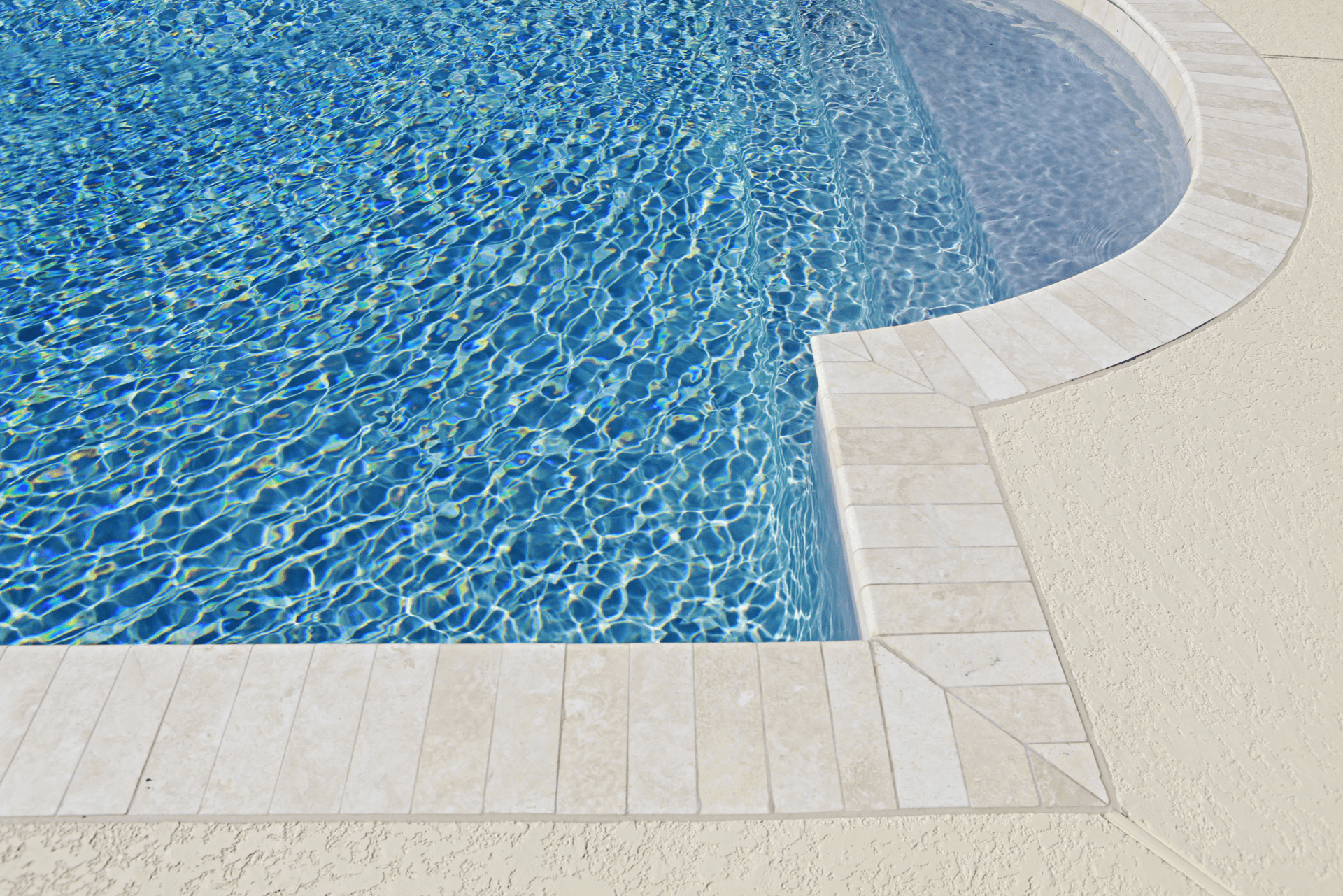
Don’t miss: The Cost of Travertine Pavers Explained
How to ease the heat in outdoor paved areas
If you have full control over your outdoors, there are adjacent measures you can adopt to prevent any heat absorption from happening in the first place. These factors can produce results that extend even beyond the realm of travertine – so make sure to study the entire worksite before hardscaping your space.
In reality, that means analyzing whether you will be able to move things around and create the custom outdoors you’ve been dreaming of. These measures include:
- Choose Lighter Colors: Light-colored travertine pavers tend to absorb less heat compared to darker ones. Lighter shades reflect more sunlight, which can help to keep the surface temperature lower. Beige or cream-colored travertine may be a good choice for this purpose.
- Use Textured or Tumbled Finish: Opt for travertine pavers with a textured or tumbled finish rather than a polished one. Rougher surfaces can dissipate heat more effectively and provide better traction, reducing the discomfort caused by hot pavers.
- Provide Shade: Install umbrellas, pergolas, or shade sails over the pool area to reduce direct sunlight exposure to the travertine pavers. This will not only keep the pavers cooler but also create a more comfortable environment for relaxation.
- Use Outdoor Rugs or Mats: Place outdoor rugs or mats strategically on the travertine pavers to provide a cooler surface for walking. These can also add aesthetic appeal to the pool area while offering a practical solution to minimize heat absorption.
- Plant Trees or Shrubs: Planting trees or shrubs around the pool area can provide natural shade and help to cool the surroundings, but make sure to choose species that offer ample foliage and can thrive in your climate. Trees are the best solution for everyone – simultaneously, you will be embellishing your neighborhood with more greenery, creating natural shadows to cool off the ambiance, and being environmentally friendly to benefit generations to come.
- Cooling Systems: Consider installing a cooling system, such as misters or evaporative coolers, around the pool area. These systems can help lower the ambient temperature, thereby reducing the heat absorbed by the travertine pavers.
- Apply Sealant: Finally, consider applying a sealant designed to reflect sunlight. These sealants can help reduce heat absorption and minimize the temperature increase of the pavers – making them more comfortable to walk on, especially around pool areas.
But speaking of sealants…
Should you really seal travertine?
This is a pivotal question that has no ultimate consensus in the hardscape world. But why?
Travertine is naturally permeable – thereby allowing water to be absorbed – which contributes to its unique character and slip-resistant properties. However, this water-absorption trait also raises concerns about the potential for staining and damage from harsh weather conditions. Sealing travertine pavers can help mitigate these concerns by creating a protective barrier that repels water, oils, and contaminants.
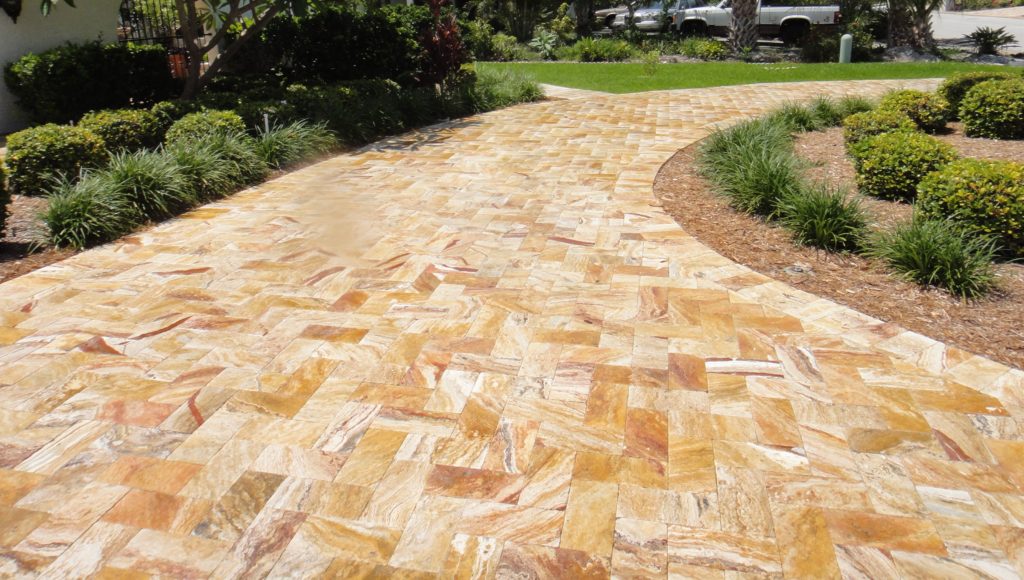
On one side of the spectrum, professionals argue that sealing travertine compromises its natural water-absorption capabilities (which, for many, are the selling point of travertine in the first place), potentially making it less suitable for poolside installations, for instance. In the end, the unsealed surface of the travertine allows water to escape, thus preventing the formation of slippery surfaces around pools and minimizing safety hazards.
If your project has no pool involved, sealing it at least twice a year is a recommended practice. On the other hand, if we’re talking about a pool deck or a city where rain is highly present, it’s best to consult with a professional for further instructions.
To read our complete guide on pavers restoration, click here.
Eagle Pavers is here to help you decide!
As professionals in the Florida hardscape business for years, trust us on this: there’s no margin of error with travertine pavers when it comes to wet areas.
As a branch of Eagle Stones, our team specializes in paver supply and installation around the county of Sarasota and Manatee, Florida. In case you’re near us, don’t hesitate to give us a call so we can get started on your project with a free estimate!
Click here to view the full online catalog – we’ll be waiting for you to reach out.
Frequently asked questions
Are travertine pavers slippery when wet?
Travertine pavers are naturally textured, which helps provide traction even when wet. This makes them relatively slip-resistant, enhancing safety around your pool area. However, it’s important to choose a finish that offers the right balance between texture and comfort.
How do I maintain travertine pavers on my pool deck?
Maintaining travertine pavers involves a few simple steps. Regularly sweep the surface to remove debris, and clean it with a mild soap solution or a specially formulated stone cleaner. Be sure to reseal the pavers every 1-2 years to prevent staining and maintain their overall appearance.
Can travertine pavers withstand the harsh chemicals used in pools?
Yes, travertine pavers are resistant to the chemicals commonly found in pools, such as chlorine. However, it’s still a good practice to rinse the pavers with clean water after exposure to pool water to prevent any chemical residue buildup.
Is travertine suitable for colder climates?
Travertine’s durability and resistance to freeze-thaw cycles make it suitable for colder climates. However, it’s important to choose a high-quality travertine with low water absorption to minimize the risk of damage due to freezing and thawing.


